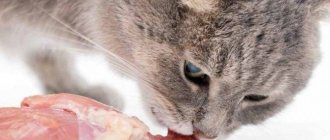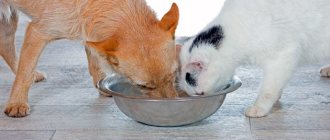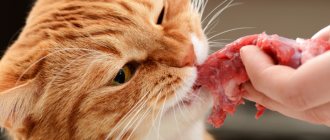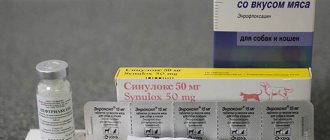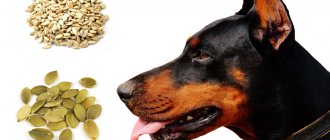Mr. Tail recommends: why dogs should not eat pork
Owners of purebred dogs who prefer natural food should know the reasons why pork meat is harmful for animals to eat.
| Factor | Consequence | Solution |
| High percentage of fat | It takes a dog 14 hours to digest. Leads to obesity and is difficult to digest by the body. Metabolic disorders, gastrointestinal disorders, pancreatitis, diabetes mellitus, liver, kidney, heart diseases. The general condition of the pet worsens, lethargy and problems with fur and skin appear. | Treat with low-fat parts, offal 1-2 times a week in winter, in summer replace with lighter ones (poultry, with the exception of chicken skins, bones, rabbit). |
| Invasive diseases (tapeworm, trichinosis, ascariasis, Aujeszky's disease) | Pork is more susceptible to the spread of dangerous parasites and infections than others. If infected, there is a risk of death. | Buy a product that has passed veterinary examination from trusted suppliers, eliminate raw meat, and carry out heat treatment (cook for at least 1 hour). |
| Volvulus | It is a myth. The danger is hidden in the increased physical activity that the dog can be exposed to after eating. | Limit activity after eating food, create a schedule of feedings, walks, and activities. |
Myths and misconceptions
Until recently, it was believed that pork was completely contraindicated for dogs and should not be included in the diet. Some especially careful owners refuse purchased food that contains this product.
The first myth is that pork is poor in chemical composition.
Recent studies have confirmed that this is a balanced product, which includes protein, B vitamins and other microelements that are beneficial to the health of the animal.
The second misconception concerns the excessive fat content of meat. Fat is concentrated in the animal carcass in certain places. For feed, use blade, carbonate or tenderloin. The product can and should be introduced into the diet of a domestic dog, but not more than 2 times a week.
It is believed that pork provokes volvulus. This is also a myth. The result of the pathology can be intense physical activity of the pet with a full stomach.
Expert opinion
Panteleeva Irina Petrovna
Breeder, 11 years experience.
Another common but erroneous opinion is that pork is poorly absorbed by the dog’s body. Scientific research has confirmed that pork meat is second only to lamb in terms of digestibility, but beef and poultry round out the top three.
In what form can pork be given to dogs?
A dog's digestive system is different from a human's. She is unable to digest fatty foods. Eating pork can lead to serious problems with the body's functionality. Lean meat is added to the diet. Feeding raw food that has not undergone sanitary treatment is prohibited. It may contain parasites and pathogens (Aujeszky, plague, etc.). Therefore, it is recommended to cook for at least 1 hour.
Freezing will not kill all parasites.
If the owner decides to introduce pork into the pet’s diet, he must adhere to the following rules:
- cook lean parts (shoulder, loin, brisket, ham), offal (heart, liver, stomach);
- It is necessary to carry out heat treatment;
- purchase the product only from trusted companies;
- Treat no more than 1-2 times a week.
Many veterinarians allow pork meat in small quantities as a dietary dish to restore the body after illness. The product will be useful in winter, when the dog accumulates fat reserves.
Is it possible to give lard?
You cannot completely eliminate lard from your dog’s diet. This can lead to skin conditions, dry skin and poor coat condition, as well as neuromuscular disorders.
It is better to use small pieces not as the main food, but as a treat or reward during training. However, you should first test for good digestibility and the absence of allergic reactions. A small piece can be given to the dog, then the body’s reaction should be observed for 24 hours. If there are no manifestations from the gastrointestinal tract, you can occasionally give lard in small quantities.
Important!
Salted and smoked lard remains strictly prohibited for all domestic animals, since excess salt can be fatal to the pet’s body.
The dangers and benefits of pork
Pig meat, like any other product, has its disadvantages and advantages.
Reasons to refuse:
- raw product (not only piglets, but also other species) should not be given to dogs without preliminary heat treatment, there is a risk of infection with parasites, in this case it is greatest;
- with constant use will lead to obesity and other dangerous diseases;
- in dogs with liver disease will cause exacerbation and deterioration of the condition;
- high cholesterol content (70 mg per 100 g of product) negatively affects the heart and blood vessels.
Pork is rich in nutrients:
- fluorine, magnesium, zinc, cobalt, amino acid lysine;
- complex of B vitamins: B1 – heart and gastrointestinal tract, B2 – vision, B6 – liver, heart, nervous system, B12 – skin, coat;
- protein (20 g per 100 g of product);
- Pork heart has the highest content of the sulfur-containing amino acid – taurine.
Why not?
Lard is pure fat, which, when entering the gastrointestinal tract, can cause unpredictable reactions in the body . Typically, street and yard dogs have a gastrointestinal tract that is more resilient and accustomed to varied and inconsistent food, and a small portion of fat eaten may not have any effect on the animal.
The gastrointestinal tract of domestic (especially decorative breeds with a sensitive digestive system) dogs, even from a small portion, can become dysfunctional .
The animal may simply begin to have diarrhea or vomiting. Even pork is not recommended to be given to dogs in large quantities and often.
The reason is the high fat content of this type of meat. What can lead to constant consumption of fatty foods in dogs:
- Liver diseases. Cholecystitis may begin, followed by pancreatitis and concomitant pancreatic disease.
- One disease immediately leads to another. Severe pancreatitis in most cases leads to diabetes mellitus.
- If you are overloaded with fatty foods, heart damage becomes quite possible. Once in the blood, fat is deposited on the walls of blood vessels, forming cholesterol plaques that interfere with normal circulation. In turn, increased blood pressure puts excessive strain on the heart and rapid wear and tear of the body.
- Impaired metabolism and proper absorption of nutrients, which can cause hair loss and allergic reactions.
- Obesity of internal organs.
- Obesity affects the behavior and reaction of the animal: passivity, depression, shortness of breath, moodiness and uncontrollability.
It is better to select food with less protein and fat content. Moreover, you need to take into account the pet’s lifestyle. The less the dog moves, the lower the calorie content of the food should be.
Consequences of feeding dogs pork
Pig meat is considered the fattest (contains 20 grams of fat per 100 grams of product), so its frequent consumption threatens obesity and problems with the liver, spleen and other vital organs of the dog’s body.
You should not give lard and fatty products to puppies whose skeletons are not yet strong. If you gain weight quickly, it will not have time to grow, which will lead to health problems:
- sagging back;
- joint dysplasia;
- incorrect paw placement.
Lean boiled meat from young pigs is beneficial for children and older pets. Requires minimal heat treatment, so it retains more beneficial properties.
If the owner still decides to treat his pet to pork, it is better to choose parts that contain less fat (for example, ham) and give it rarely (1-2 times a week).
Why is pork considered harmful for dogs?
It is quite fatty and very well digestible. Dogs willingly eat it. But excess weight with a large amount of such food is inevitable. In addition, the pancreas and gastrointestinal tract suffer when feeding fresh lard and fat. This leads to gastric arrest, diarrhea, and pancreatitis. This is why dogs should not eat fresh pork in large quantities.
Fat content of meat
For a clearer picture, you should compare the main types of meat on our market by indicators
| Ham | Squirrels | Fats | Calorie content |
| g/ 100 g product | g/ 100 g product | Kcal | |
| Pork | 16 | 21 | 261 |
| Beef | 19 | 13 | 261 |
| Mutton | 18 | 18 | 232 |
From the above it is clear that pork contains the most fat, but the indicators are not critical.
Parasites and infections
Pork is dangerous due to the following parasites:
- Trichinella and Toxocara are nematodes and roundworms.
- Fluke parasites.
- Tapeworms, echinococci and representatives of a number of tapeworms.
Infectious pathogens are toxoplasma and sarcosporidium, they are also protozoa.
Important! For this reason, pig meat must be subjected to deep freezing or high temperatures, depending on how it is fed to the dog.
Meat in a dog's diet
Following a diet and introducing into the diet only those foods that will be beneficial is the key to the successful development of a dog. Especially in the first year of life, when the puppy is actively growing and getting stronger.
Pork meat contains substances that are beneficial to the dog’s body (vitamins, amino acids, microelements). The amount of protein in it (16 g/100 g) is less than, for example, in beef (19/100) or lamb (18/100). A high percentage of fat (20/100) has a negative effect on the digestive system. It is not digested, but accumulates in the liver cells and leads to obesity. Physical activity will not help cope with the disease, this is how dog physiology works.
To avoid weight gain and subsequent health problems, the owner should limit the consumption of pig meat in the pet’s diet.
How to give pork to a dog?
Despite the fact that all animal proteins pose a potential threat to pets, the dog’s body will not be able to ensure normal functioning without their consumption. Each owner should independently decide whether to add pork to their pet’s diet or not. If you decide not to exclude pork, you must follow the following rules and recommendations:
You should not feed your dog pork every day. Preference should be given to boiled meat with a small amount of fat. If you need to include pork in your dog’s diet on a daily basis, you should opt for offal.
Fact!
Frozen meat also retains infection if it has been exposed to contamination.
It is allowed to feed a dog with pork meat purchased exclusively in stores and retail outlets where the product is sold that has passed the examination.
Many veterinarians today are changing their attitude towards pork and prescribing consumption in small quantities to dogs who have suffered from various diseases and when following diets - in order to speed up the pet’s recovery process.
Diseases that occur in dogs after eating pork
Aujeszky's disease
This disease is better known as pseudorabies. The disease is common in farm and domestic animals, as well as in rodents and poultry. It is spread by pigs who have recovered from or are carriers of the virus.
Dogs become infected by eating raw meat or by contact (living nearby) with carriers.
Symptoms begin with a lack of appetite, and then with further refusal of food. The animal begins to salivate profusely
and itching in the nose, ears, lips. The endless itching and the dog's attempts to calm it are reminiscent of rabies. Therefore, Aujeszky's disease is sometimes called pseudorabies.
An effective treatment for the disease has not yet been invented. The outcome is almost always fatal, because the obvious signs only appear for a day or two and there is very little time to identify them.
The most important thing is disease prevention:
- extermination of rodents and food securely hidden from them;
- control over the food received, the absence of raw meat from animals with Aujeszky's disease on the menu.
Trichinosis
The disease gets its name from the small roundworms Trichinella. Infection occurs due to eating raw or poorly processed meat. Why can you get infected from pork? Yes, because pig feed contains meat waste, which can be infected with larvae.
Trichinella larvae have high vitality and are able to survive even after frying.
, pickling, smoking, cooking. Once in the body, the larvae grow into adults and can live in the intestines for several months, and even in the muscles for several years.
Signs of the disease include fever, muscle and abdominal pain, and sometimes diarrhea.
The more worms that enter the body, the more severe the disease.
Pork meat and dog diseases
In addition, pork can lead to the following diseases:
- Aujeszky's disease, also called pseudorabies. This disease is caused by eating raw pork or coming into contact with infected pigs. The symptoms of the disease are similar to those of rabies; they appear 1-2 days after infection and leave no time to determine the diagnosis. Most often it has a fatal outcome.
- Toxocariasis. With this disease, worm larvae, once in the body, spread throughout all internal organs, successively affecting the heart, brain and other organs.
- Teniasis (or tapeworm). Symptoms include decreased body weight and stunted growth of the dog, which leads to damage to the central nervous system and ultimately death.
Video: foods harmful to dogs!
Most dog breeders know that feeding their pet pork is very, very undesirable. However, not everyone is aware of what exactly caused this ban and whether it is so categorical. After all, the closest relatives of domestic dogs in the wild – wolves – eat wild boar meat, so why shouldn’t you give pork to dogs?
When talking about the ban on pork meat, dog owners are often guided by the following arguments. But are all of them justified?
Unfortunately it's true. At present, sanitary standards for keeping animals, veterinary control and growing technology are not always observed on pig farms. As a result, subsequent generations of pigs do not develop immunity to a number of diseases. These animals can be carriers of diseases such as:
- helminthiasis (and its varieties) – damage to the dog’s digestive system by worms;
- Pork tapeworm is a fairly rare, but very dangerous disease, during which the dog loses weight, suffers growth retardation and various damage to the central nervous system.
- Aueszky's disease (second name is “latent rabies”) - the disease progresses very quickly (1-2 days), and, as a rule, ends in death. The main symptoms are severe itching in the head and muzzle, profuse salivation.
- trichinosis - occurs when a dog eats raw, contaminated meat and is characterized by diarrhea, abdominal pain and fever. The larvae of the causative agent of the disease - Trichinella - are extremely tenacious and can even survive heat treatment of meat.
Pork is also harmful to dogs due to its fat content. In large quantities, this meat is not absorbed by the dog’s body and provokes intestinal disorders. This happens because dogs do not have enough enzymes needed to break down pork fat. Regular consumption of pig meat leads to diseases and pathologies such as:
- enteritis;
- cardiovascular diseases;
- diabetes;
- liver and kidney problems;
- dangerous metabolic disorders.
Penetrating into the body, undigested pork fat enters the blood, which increases cholesterol, promoting the formation of plaques, and leads to obesity in the internal organs. All this negatively affects the dog’s behavior: he can become inactive and passive.
Pork can cause volvulus
But this argument hardly has any validity. After all, intestinal volvulus occurs, as a rule, from physical exertion on a full stomach. What the dog is fed does not play a role here. Volvulus most often occurs in young shepherd dogs, so you need to plan their diet and physical activity with caution.
However, you still shouldn’t place a complete and unconditional taboo on pork meat. Yes, it should not be included in a dog’s daily diet, but sometimes you can still pamper your dog: for example, as a treat. In the winter season, animals need fat to protect them from frost, and therefore once a week the dog can be treated to not too fatty slices of pork. When planning the menu for your four-legged friend, it is recommended to adhere to the following rules and notes:
It is worth noting that nowadays dog handlers and veterinarians are no longer so categorical about this type of meat. Pork contains substances that are beneficial for the dog’s body: iron, vitamins, amino acids, zinc, etc. Therefore, in moderate quantities there will be no harm from it, the main thing is to choose meat with as little fat as possible and in no case overuse it.
It is also important to monitor the condition of your pet specifically after eating pork, because each dog is individual. As with any issue related to caring for a dog, the owner should show attentiveness, caution and lack of fanaticism.
No other type of meat is as hotly debated as pork. Nutritionists advise people to limit their consumption. Veterinarians, and after them all breeders and animal owners, when asked whether cats and dogs can eat pork, tirelessly repeat: no to pork, under no circumstances and under any circumstances!
However, recently, the still timid voices of specialists have begun to be heard, trying to rehabilitate the “eternally damned” type of meat and even bring very significant arguments in its favor.
Pork meat and dog digestion
Due to its high fat content, pork meat, when consumed in large quantities, is difficult for the dog’s stomach to digest, as mentioned above. Therefore, fat accumulates in the liver cells, and this, in turn, causes the dog to become obese.
Getting rid of obesity is an extremely difficult task. Nature dictates that a dog’s body does not digest heavy food. Therefore, even if pork meat is a good product for humans, this does not mean that it is suitable as food for a dog. Even if the meat does not contain harmful bacteria and microorganisms that can lead to infection, it can be harmful to the dog. Thus, one of the most dangerous diseases that threaten a dog’s health, “distemper,” occurs as a result of feeding a pet pork.

